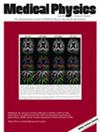Beam collimation and filtration optimization for a novel orthovoltage radiotherapy system
Abstract
Background
The inaccessibility of clinical linear accelerators in low- and middle-income countries creates a need for low-cost alternatives. Kilovoltage (kV) x-ray tubes have shown promise as a source that could meet this need. However, performing radiotherapy with a kV x-ray tube has numerous difficulties, including high skin dose, rapid dose fall-off, and low dose rates. These limitations create a need for highly effective beam collimation and filtration.
Purpose
To improve the treatment potential of a novel kV x-ray system by optimizing an iris collimator and beam filtration using Bayesian techniques and Monte Carlo (MC) simulations.
Methods
The Kilovoltage Optimized AcceLerated Adaptive therapy system's current beam configuration consists of a 225 kVp x-ray tube, a 12-leaflet tungsten iris collimator, and a 0.1 mm copper filter. A Bayesian optimization was performed for the large and small focal spot sizes of the kV x-ray tube source at 220 kVp using TopasOpt, an open-source library for optimization in TOPAS. Collimator thickness, copper filter thickness, source-to-collimator distance (SCD), and source-to-surface distance (SSD) were the variables considered in the optimization. The objective function was designed to maximize the dose rate and the dose at a depth of 5 cm while minimizing the beam penumbra width and the out-of-field dose (OFD), all evaluated in a water phantom. Post-optimization, the optimal beam configuration was simulated and compared to the existing configuration.
Results
The optimal collimation setup consisted of 2.5 mm thick tungsten leaflets for the iris collimator and a 350 mm SSD for both focal spot sizes. The optimal copper filtration was 0.22 mm for the large focal spot and 0.15 mm for the small focal spot, with a SCD of 148.5 mm for the large focal spot and 125.8 mm for the small focal spot. For the large focal spot, the surface dose rate decreased by 9.4%, while the PDD at 5cm depth () increased by 7.7% compared to the existing iris collimator. Additionally, the surface beam penumbra width was reduced by 31.3%, and no significant changes in the OFD were observed. For the small focal spot, the surface dose rate for the new collimator increased by 3.7% and the increased by 5.3%, with no statistically significant changes in the beam penumbra width or OFD.
Conclusion
The optimal beam collimation and filtration for both x-ray tube focal spot sizes of a kV radiotherapy system was determined using Bayesian optimization and MC simulations and resulted in improved dose distributions.


 求助内容:
求助内容: 应助结果提醒方式:
应助结果提醒方式:


